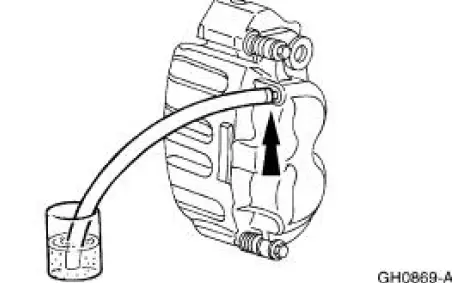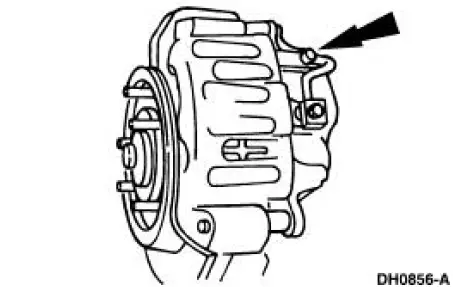Ford Mustang (1999-2004) Service Manual: Caliper
1. NOTE: It is not necessary to do a complete brake system bleed if only the disc brake caliper (2B120) was disconnected.
Place a box end wrench on the disc brake caliper bleeder screw (2208). Attach a rubber drain tube to the disc brake caliper bleeder screw, and submerge the free end of the tube in a container partially filled with clean brake fluid.

2. Have an assistant pump the brake pedal (BP) (2455) and then hold firm pressure on the brake pedal.
3. Loosen the disc brake caliper bleeder screw until a stream of brake fluid comes out. While the assistant maintains pressure on the brake pedal, tighten the disc brake caliper bleeder screw.
- Repeat until clear, bubble-free fluid comes out.
- Refill the brake master cylinder reservoir (2K478) as necessary.
4. Tighten the disc brake caliper bleeder screw. Refer to Specifications.

 Four Wheel Anti-Lock Brake System (4WABS) Hydraulic Control Unit (HCU)
Four Wheel Anti-Lock Brake System (4WABS) Hydraulic Control Unit (HCU)
NOTE: This procedure only needs to be performed if the 4-wheel
anti-lock brake (4WABS) hydraulic
control unit (HCU) has been installed new or if the HCU lines have been
opened.
1. Clean all ...
Other materials:
Trim Panel - Quarter, Coupe
Removal and Installation
1. Remove the upper quarter trim panel. For additional information,
refer to Trim Panel-Upper
Quarter in this section.
2. Remove the scuff plate.
3. Remove the pin-type retainers.
4. Lower the rear seat backrests.
5. Rem ...
Battery and Cables
Vehicles are equipped with a 12 volt maintenance-free battery that
contains a built-in hydrometer. The
hydrometer eye indication is as follows:
A green dot means the battery is OK.
A yellow dot, red dot, or when the green dot is not visible,
...
Accessory Drive Belt - 4.6L (2V) and (4V)
Removal and Installation
Mach I
1. Remove the air intake scoop. For additional information, refer to Section.
Cobra
2. Remove the supercharger drive belt cover.
3. Rotate the supercharger belt tensioner clockwise and remove the
supercharger belt.
4. Remov ...

